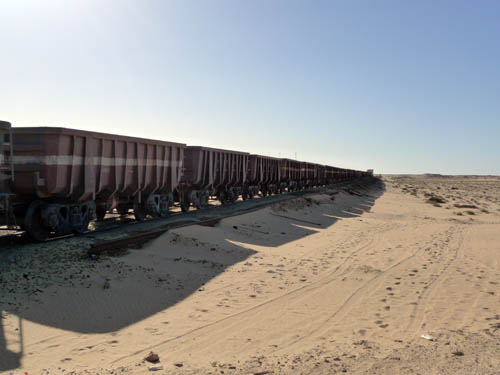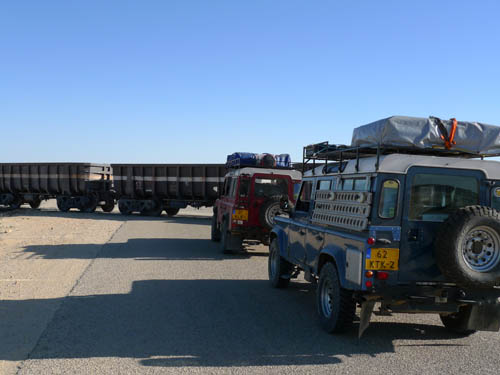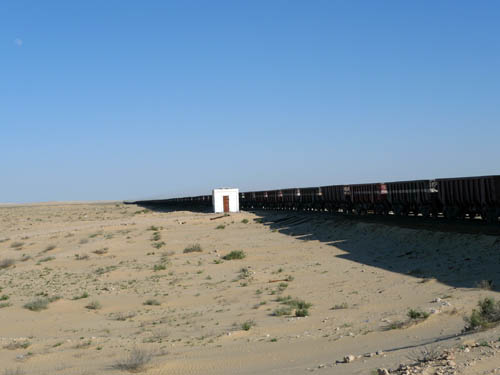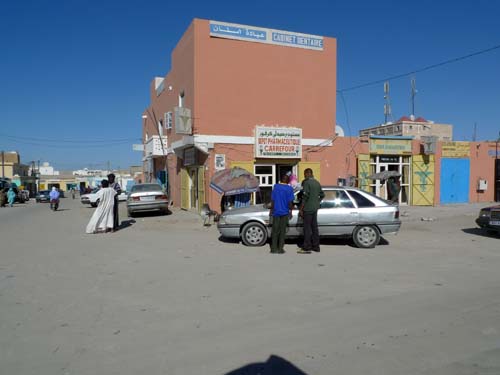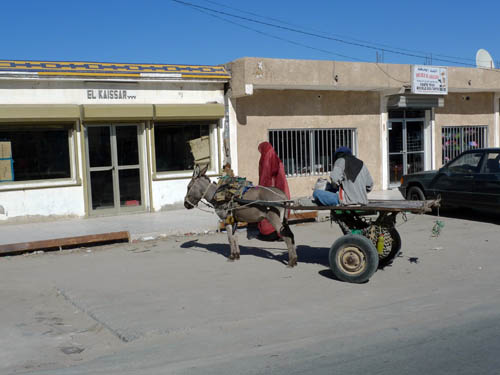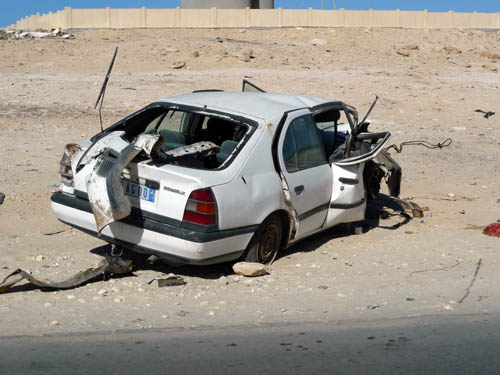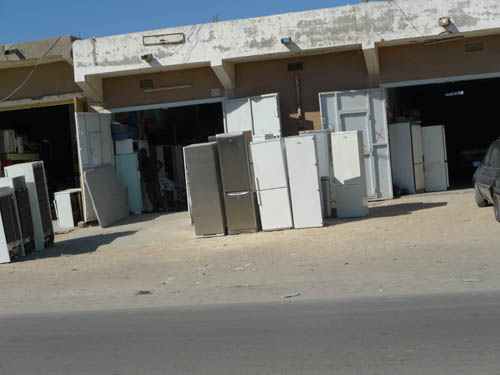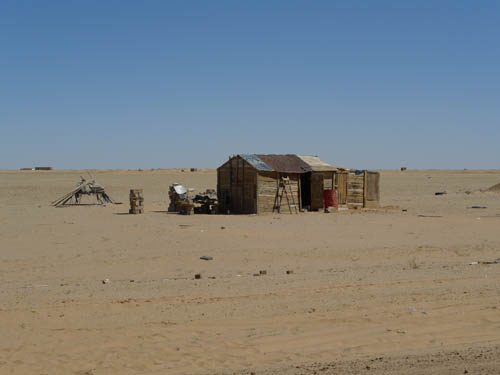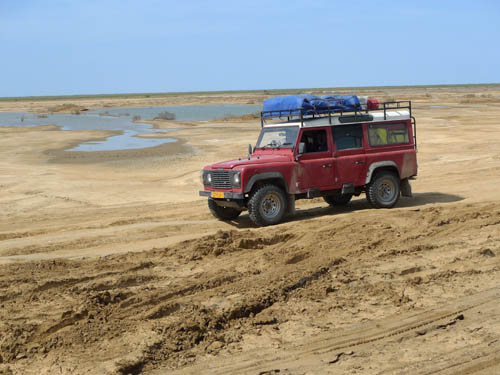Mauritania
Mauritania Border and Nouadhibou
We manage to spend 7 days in Dakhla – we aren’t sure how but the days just go by. We leave on Weds the day of the Muslim Tabaski celebration to cross to Mauritania. This holiday was described to Julia as “sort of like Christmas but without the presents”. Hmmmmm, Christmas has never really involved the public slaughter of thousands of sheep in Minnesota – not sure about other parts of the world. I think the point was more that Tabaski is a huge holiday – people go back home and things generally shut down for the week.…The 250kms to the border there is almost nothing. A few petrol stations and endless hot sandy space. We stop at the last petrol station before the border and see about 20 cars from Dresden, Germany. A rally that will be heading to the border. We jump back in the cars and make for the border. Don’t want to get stuck behind 20 cars at the border! We have a relatively quick and painless exit from Morocco Then we enter the 8Km stretch of no man’s land separating Morocco from Mauritania. There is no road. It is sand dunes and abandoned sometimes land-mined cars (a few old refrigerators and some chairs, a bit of other trash). It seems there are people living there, or at least ‘working’ there. There are some scruffy people in an old abandoned caravan, slick money changers with nice Mercedes. There are plenty of car skeletons, stripped down to various levels. And people emerge from behind dunes and shrubs as they hear our car. We had been told that the people there make sand traps to try and stall cars. They will then dig you out for a fee. We have no trouble making it in the Land Rovers – but have no idea how the big transport trucks manage! After a very strange 20 minutes or so we are through the no man’s land to the Mauritanian border post. Again, the border formalities are pretty straightforward. The only oddity is they only have paid parking (in the middle of absolutely no where with only the border post) – we got a parking receipt and everything! We drive from the border through the middle of nowhere towards Nouadibou, when there is an old train track. More for fun Stanley looks left and then right and incredibly enough there is a train coming!!! We later read there is one train a day and is apparently known as the longest train in the world measuring an estimated 2.1 km (approximately 200 wagons but we lost count). We are definitely in Africa now – Sub-Saharan Africa as we recognize it. There are small shops lining the dusty and potholed streets, overloaded trucks like mushrooms in the distance, astounding forms of public transport. We spend the night at a campsite in town and leave the next morning for Parc Banc D’Arguin.
There is not much marked on the map in Mauritania and it is a true representation. Unlike Morocco where the main cities or villages are on the map but you very often go through small villages along the way there is nothing along the road in Mauritania. Even a marked village turns out to be nothing more than a clump of tents. It is beautiful scenery and the tar road not bad.
Parc d’Arguin
We take the tar road from Nouadibou to Chami where there is a sun faded sign leaning by the side of the road for the Park headquarters which consists of a very friendly sun-worn warden in a modified shipping container. As Stanley is discussing the park and entrance with the warden the police drive up and scold us for not stopping at their checkpoint. We didn’t stop at the checkpoint because it is at least 500meters beyond where we pulled off the road. They tell us next time we should go to the police checkpoint and then go back to where we are going.
As an aside, Mauritania LOVES police checkpoints. And at every checkpoint they ask for a Fiche – a paper that we are supposed to have printed out to hand them which contains our passport and personal details. If you don’t have a fiche to hand over you have to wait AGES while they copy your passport and car registration details into some book. By the time we pass through Mauritania we have handed over almost 16 fiche!
We pay the entrance and camping fees and he tells us just to “follow the fresh tracks” to get where we are going. That is not at all obvious (there is no road). We enter GPS waypoints and head off into the desert. It is dry and hot and sandy. We drive for an hour or so and we can smell the sea and feel the moisture in the air before we can even see water. We camp at Community Campsite just outside the ‘town’ of Iwik which is comprised of about 100 shacks along the shore. The owner is very friendly but speaks no identifiable language. He makes us Mauritanian tea. It is not at all like the sweet mint tea in Morocco and has its own ceremony. As in Morocco the tea is served in tiny glasses – only slightly bigger than a shot glass and the tea must be poured into the glass from a small pot from as high as possible. I wouldn’t have a chance of getting any in the glass but these guys have great aim. There is a lot of pouring going on to get the first glass and then the tea is discarded. Apparently the first glass only makes the foam for the other glasses and then tea is added (so you have a shot glass of sweet strong tea with a foam head). Through a few words and some pantomime we learn that it is polite to accept 3 cups of tea – not more.
That evening Stanley goes to ‘town’ to arrange a boat to take us to the islands the next day. The boats are for fishing. If they have someone to take out during the day they won’t go fishing the night before so we must make arrangements that evening. In contrast to Al Hoceima NP – which no longer exists and Souss-Massa NP which is now a residential area Parc Banc d’Arguin is seemingly untouched. It consists of a number of uninhabited islands where literally millions of migratory birds reside. We had never seen so many birds together as in PN Banc d’Arguin with numerous species such as Western Reef Egret, flamingos, pelicans, Caspian and Royal tern and many more. There were swarms flying in the air and clustered together on the shore – very beautiful. At eleven o’clock it was time to head back in order to be back at around 2pm. Unfortunately, the wind just gave up and it took nearly 6 hours to drift back to shore in the blazing sun. Luckily, we had ordered for some lunch and there was now plenty of time to cook and eat. We ate one of the best baked fish - : a Mullet Jaune. Once we finished the first one, they started cooking the second, mmmm.
Arriving at the tent later than expected we had asked our Mauritanian host to make us some dinner and guess what: mullet jaune, but now grilled. Equally good if not better prepared than the fish we had for lunch. After the three cups of tea we watched some photo’s with our host and great guide of the day (Ahmed Medou) before retreating to our tents.
Nouakchott
Two things about Nouakchott – an enormous fish market and Mercedes cars.
The market stretches along the beach front about 5km out of town. As you look down the beach there are hundreds of brightly colored fishing boats in either direction. Men are bathing or sitting in groups under makeshift canopies next to the boats. There are various groupings of cement stalls with fish laid out and in piles and some impromptu selling points where the fish is just in boxes or big plastic basins and people descend on it to purchase or look over. We go in search of our now favorite mullet jaune. After some back and forth we determine that ‘daum’ is mullet jaune, pick a large one which is whisked away and cleaned.
80% of the cars in Nouakchott must be Mercedes but they are in the most horrible condition – even the NEW models are in wretched condition. Stanley thinks Nouakchott is where the crash test cars are sent and that is really what it looks like.
Keur Masene - Diamma – Border
The only thing stranger than the entrance into Mauritania is the exit. We avoid Rosso due to its infamous reputation for being a nightmare and opt for the other crossing to Senegal at Diamma. There is no road to Diamma marked on our map. We have some GPS coordinates for a road and head off. We pass the ‘turn off’ because we didn’t see anything that looks like a road. We drive a few Kms on and decide to turn back to the waypoint. We turn off per the coordinates(there is in fact a dirt road) and follow the track. It does look as though they are grating a new road and the dirt track isn’t bad – for the first 40kms. We come to a police checkpoint and think – ahh, the border. It turns out no, the border is another 40 kms. Then the road gets pretty bad. We have been told that Diama is a ‘dry season option’ and largely impassable in the wet season. It hasn’t been raining but the ruts and pot holes in the dirt track from when it was make driving slow. Again, there are no signs. The drive is beautiful and actually takes us through a National Park du Diawling. We stop often for bird watching and taking in the scenery. Finally we come to the town of Keur Masene which we think may be the Mauritania side of the Diamma border . The only sign is one we see out of the corner of our eye but it is facing the wrong direction and there are no further instructions about which way the border is. No one is forthcoming with any assistance and we pick a direction based on the GPS and drive on. We are driving through swamp on precariously raised dirt partitions hoping that there is no oncoming vehicle as someone would have to reverse or go into the water. We can see some other vehicles on other partitions going in different directions. We come to a dry mud flat and see a truck (broken down offloading its cargo). The guys tell us border is straight on and then to the right. We have been in the middle of nowhere with no villages and no signs for kilometers and are now driving through swamp/trees to the border!! We finally emerge onto a road and are stopped at a police checkpoint. Then a park warden approaches us and tells us we have to pay the park entrance fee. CHEEKY! We had to drive through the park to get to the border and then they come at the end and ask for a fee. We pay and move on to the border. Indeed Diamma border crossing is mellow – how could anyone ever get there!! We pay a few exit taxes and are on our way to the Senegal border in 30 minutes.
Mauritania is separated from Senegal in its southern border by the Senegal River. At Rosso the crossing is served by a ferry and at Diama there is a dam and a bridge. At the end of the bridge just before the Senegal side there is a barrier. A man came running over demanding 4,000CFA per car. Stanley and Niels went past him to the first office to see if this was correct and indeed we do have to pay. We take a loan from the woman who runs the café (who also changes money and sells the car insurance/Carte Bruin). We had been told that Senegal did not accept the Carnet du Passage and we would need to purchase a ‘Passevant’. Customs tells us they are in fact now taking the Carnet (recent change of mind). However you can only get the stamp for the Carnet in Dakar and must do so within 24 hours. What?? We weren’t even planning to go to Dakar and to travel the 250ks means we will need to leave early the next morning in order to make it to customs. It is already late and we decide to drive into Saint Louis (or just South of) to Zebrabar for the night – maybe they can help us with the new regulation as well….


